Flipping through the glossary of my student’s high school world history textbook (I tutor history on the weekends, one of the sole professional manifestations of my recently-completed master’s degree) I was amazed to find that of the hundreds of key terms the book highlights, of which at least a hundred or so are people, there remain only two key terms that are historical women. Think about that. Two, out of five thousand years of history, deemed worthy of emphasis.
More surprisingly, perhaps, are the two who carry this high honor: Hatshepsut, a 15th-century BCE queen of Egypt’s 18th dynasty, and Eva Perón, the wife of 1940s Argentinean president Juan Perón (also a key term).
It’s a given that women are underrepresented in history books, and in history in general. Most of the chapters in our textbook, be it on ancient Egypt or Renaissance Italy or the Mongol Empire, have a subsection which should effectively be titled “So, what were women doing while all this other stuff was going on?”, just to, you know, remind us they existed. Answers variously include “being/not being allowed to own property” and “being/not being allowed to get a divorce.”
It’s not the problem of this particular textbook by any means, and neither is the scholarly field of history and its practices entirely to blame. Sources from the point of view of women, or concerning women, are scarce in many historical eras and in many countries, and that’s something historians just have to deal with. Those who focus on women’s history make do with limited sources, piecing together as full a picture as is humanly possible of women’s lived experiences.
Still, it was a little dismaying to realize just how limited female representation in the history books is. So I aim to expand that representation just a bit—a great big thank-you to those ladies who made us look good, or at least, made us look powerful (and let’s face it, power is the paradigm that never goes out of style).
Today’s historical woman: Hatshepsut, the first of those two lucky ones who made it into the third edition of The Earth and Its Peoples.
Hatshepsut was born the daughter of the Egyptian pharaoh around 1500 BCE. She married her half-brother, Thutmose II (don’t judge—it’s a different culture), who became pharaoh at their father’s death. The two had no sons, though Thutmose II did produce a male heir with another wife. However, when Thutmose II died, his son, Thutmose III, was still just a boy, so Hatshepsut took the throne as the king’s regent.
This in and of itself wasn’t so unusual: a woman taking on the kingship as a kind of “interim” ruler while the real heir grew out of childhood had happened before. But Hatshepsut’s reign was different. After a few years, she proclaimed herself pharaoh and began to take her kingly duties more seriously, participating in kingly rites and building monuments. And everyone knows that building a monument is basically just a giant “hey, look how great I am” to the world.
One of the most interesting things about Hatshepsut was that, in assuming the unlikely role of female pharaoh, she adopted a masculine role with all the trappings associated with that gender. Early on, visual evidence shows a synthesis of male and female imagery: in some temple reliefs, Hatshepsut is wearing a woman’s gown, but stands with her feet wide apart in a decidedly masculine and kingly stance.
Later, however, her female gender is effectively obscured, with depictions losing their female traits altogether and instead portraying the traditional male traits of the pharaoh, down to the false beard. Hatshepsut was not trying to change her gender, however; her depiction as a male king was more an avenue towards kingly legitimacy, in a society where female pharaohs were unheard-of and females thought unfit to rule kingdoms by religious law.
What Hatshepsut attempted in becoming a male king of Egypt, while different in style and convention, seems to me to continue to exist in the 20th and 21st centuries. Female politicians have often had to prove themselves in a male-dominated milieu, adopting what are considered “tough” and “masculine” traits because that’s what is expected of a world leader (or, looked at another way, those women who do adopt these traits are the ones likely to be considered successful leaders). Some of the most aggressive foreign and domestic policy of the latter half of the 20th century has been undertaken by women, from Golda Meir in Israel to Margaret Thatcher in the UK. This “necessity” for masculine legitimacy can also, probably, be seen in more innocuous ways: the prevalence of pantsuits, the stone-faced expression. (Remember when everyone freaked out because Hillary kind-of-sort-of cried during an election stop in 2008?)
Hatshepsut’s stepson Thutmose III took over following her death, and during his reign he made what appeared to be a systematic effort to erase his stepmother from the record books. He removed her name from the king’s record, took down monuments, defaced images: all a clear attack on her personal legitimacy as well as a major blow to the whole female pharaoh phenomenon. I guess the last laugh is on ol’ Thutmose, though, because today, Hatshepsut is remembered as one of Egypt’s most successful pharaohs.
And she’s an AP World History key term. If that’s not success, I don’t know what is.


